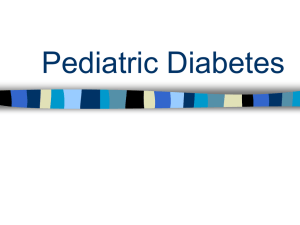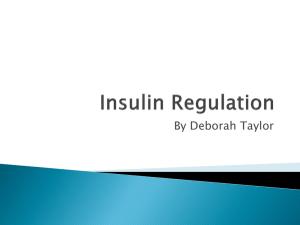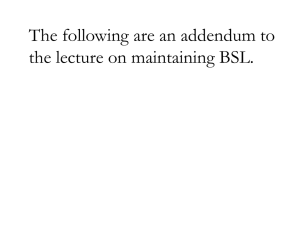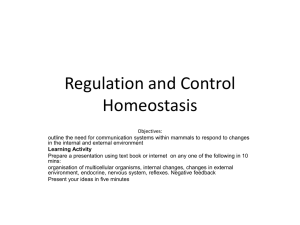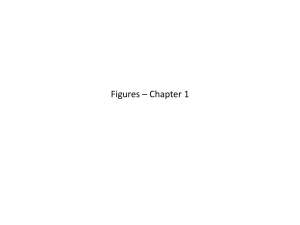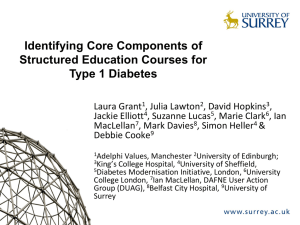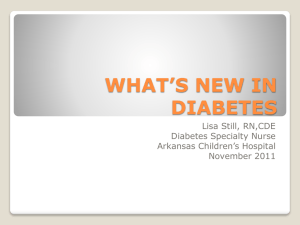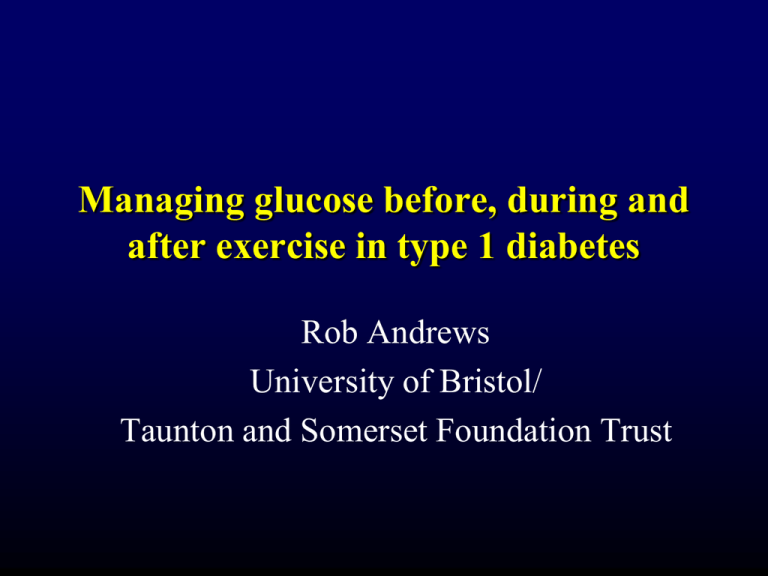
Managing glucose before, during and
after exercise in type 1 diabetes
Rob Andrews
University of Bristol/
Taunton and Somerset Foundation Trust
Uncertain
/ Limited data
Beneficial
Beneficial
Fitness
Fitness
Insulin requirement
Insulin requirement
Lipids
Lipids
Endothelial function
Endothelial function
Mortality
Mortality
Insulin resistance
Blood pressure
CVD
Beta cell function
Wellbeing (only children)
Glycaemic control
Microvascular
Microvascular
complications
Osteoporosis
Cancer
Uncertain
/ Limited data
Type 1
diabetes
Type 2
diabetes
Beta cell function
complications
Osteoporosis
Cancer
CVD
Blood pressure
Wellbeing
Glycaemic control
Physical
activity
So what do Specialist in Diabetes
know about exercise and diabetes?
Result of survey of diabetes HCP – No 138
70
60
50
40
Very confident
Broadly confident
30
Not so confident
Not confident at all
20
10
0
The value of
exercise
Types of
exercise
Exercise
Effect of
When it is
intensity and exercise on
safe to
duration blood glucose exercise
Insulin
Diet & fluid Carbohydrate
adjustment replacement
counting
for exercise for exercise
Exercise and blood sugar
HCP knowledge on what to do with high BG (>13), and
slightly low 3.6 was good but
• 75% HCP did not know what to do with patients
who had has severe hypo night before
• 50% HCP did not know what to do with BG of 5.5
• 75% did not know what to do with blood sugar of
1.8
Doctors no better than nurses or dietitians.
Exercise and insulin
Fast acting insulin
• 1/3 of HCP not clear as what should be done with fast
acting insulin if exercising 2 hours after a meal
• 55% HCP not sure what should be done with fast
acting insulin if exercise before breakfast
Long acting insulin
• 50-80% HCP (dependent on time of day) not knowing
what to do with background when exercising
Doctors significantly worse than nurses or dietitians.
Exercise and injection sites
Where to inject
• 1/3 of HCP did not know the injection sites that
should be avoided when cycling or lifting weights.
Doctors no better than nurses or dietitians.
What you need to know
• Type of exercise
Aerobic exercise
Aerobic exercise
is physical exercise of
relatively low
intensity that depends
primarily on the
aerobic energygenerating process.
Aerobic
•
•
•
•
•
•
•
•
Hiking
Golf
Road cycling
Cycle tour
Mountain biking
Distance running
Distance swimming
Triathlon, etc
Anaerobic exercise
Anaerobic exercise is exercise intense enough to
trigger use of non oxygen using metabolism. It
normally last less than 2 minutes
Anaerobic exercises
•
•
•
•
•
Weight lifting
Body Building
Dressage
Fencing
Track and field events
(Javelin, Shot put, Long
jump, Pole-vault, High jump,
Sprinting)
• Archery
• Wrestling
Hormone concentration
Hormonal response to exercise - 1
Exercise
Recovery
160
120
80
40
GH
Cortisol
Glucagon
Testosterone
Noradrenaline
Adrenaline
G ro w th Ho rm o n e C o n cen tratio n ( g .l -1 )
Hormonal response to exercise - 2
E x e rc is e
30
or
R est
#
20
Rest
Resistance
Sprint
Endurance
#
10
a
c
a
0
B a s e lin e
0
40
20
60
T im e (m in )
Kate L. Gilbert et al 2008
Hormonal response to exercise - 3
Aerobic
Anaerobic
Summary 1
• With Aerobic exercises blood sugars will tend
to fall.
• With anaerobic exercise blood sugars will tend
to rise
What you need to know
• Type of exercise
• Intensity of the exercise
Hormonal response to exercise - 4
Dependent
Exercise intensity
Hormone concentration
•
•
•
•
•
•
Exercise intensity
Type of exercise
Competition
Body temperature
Age
? Blood glucose
Independent
0
20
40
60
80
V02 max
100
•
•
•
•
Circadian rhythm
Meal time
Menstrual cycle
Sex
Fuels used during exercise
Lactate during exercise
Insulin in response to different exercises
20
b
18
serum insulin (mIU/l)
16
14
12
E
F
10
8
Sprint
Weight training
Endurance
6
4
c
2
0
pre- end
-10
0
10
20
30
time (min)
40
50
60
Summary 2
As the intensity of exercise rises
• Glucose becomes the major fuel
• Lactate levels rise
• Insulin levels rise to compensate for this
Cardiovascular response to exercise
Systolic BP
200
180
160
140
Heart rate
120
160
140
120
100
80
60
Rest
Exercise
Recovery
Borg Scale
6
7
8
Very Light
<90bpm
9
10
11
12
13
14
Light
Moderate
~100-110bpm
~120-130bpm
15
>16
Heavy
146-160bpm
Under 6 = Rest
Over 16 = Very Heavy
Summary 3
• Exercise induced HR rise is Less in patients
with Type 1 Diabetes
• Thus using Predicted HR for training is not
very useful in patients with Type 1 Diabetes
• One helpful scale that can be used is the
borg scale
What you need to know
• Type of exercise
• Intensity of the exercise
• The length of the exercise
Normal response to exercise
Pre
Prepares body
Insulin resistance
GH and Cortisol rise
Activation of CNS
Increased lipolysis
Increased glucose
Output
Glucagon levels Rise
Adrenaline levels Rise
Exercise
Insulin levels fall
Hormones during exercise.
Liver
Muscle
Glycogen
Adrenaline
Noradrenaline
Glucagon
Glucose
Glucose
Glucose
Insulin
Pyruvate
Co2
Cortisol
Glucagon FFA’s
Glycerol
Amino acids
Cortisol
Adrenaline
Noradrenaline
GH
T4
T3
TG
Summary 4
Fuel for exercise comes from three sources
• Muscle (few minutes)
• Liver (40 minutes)
• Fat breakdown
And is under the control of hormones
Response to exercise in diabetics
Pre
Prepares body
Insulin resistance
GH and Cortisol rise
Activation of CNS
Reduced lipolysis
and decreased
glucose output
Glucagon levels Rise
Adrenaline levels Rise
Exercise
Insulin levels fall
Hormones during exercise in diabetes.
Liver
Muscle
Glycogen
Adenaline
Noradrenaline
Glucagon
Glucose
Glucose
Glucose
Insulin
Pyruvate
Co2
Cortisol
Glucagon
FFA’s
Glycerol
Cortisol
Amino acids
T4
T3
Adrenaline
Noradrenaline
GH
TG
Summary 5
• In patients with T1DM less fuel comes
from the liver and fat, with the fat more
effected than the liver.
• So glucose may be needed for short bouts
of exercise and definitely will be needed
for longer durations of exercise
What you need to know
•
•
•
•
Type of exercise
Intensity of the exercise
The length of the exercise
When they are exercising in relation to
their fast acting insulin
Insulin Sensitivity: 1922 Lawrence
Plasma glucose mmol.l-1
14
12
10
8
6
4
No Insulin
Insulin
2
0
30
60
120
Time mins
240
Different insulin regimes
Actrapid or Humulin S
Hypo risk
Novorapid or Humalog
Hypo
0
2h
4h
6h
Summary 6
• Glucose falls quicker during exercise
when insulin is around.
• Adjustments in insulin or glucose intake
will thus need to be made if exercising
within 2-4 hours of taking insulin
What you need to know
•
•
•
•
Type of exercise
Intensity of the exercise
The length of the exercise
When they are exercising in relation to their
fast acting insulin
• What time of day they are exercising
Changes in insulin sensitivity with exercise
Changes in glucose with exercise
Summary 7
Insulin sensitivity increases
• During exercise
• For an hour after exercise
• At 6-8 hours post exercise
Glucose thus needs to be watched at 2
time points
How to do it!
Step 1: Dietary intake
Diet
33 yr female, diagnosed type 1 DM age 16
Training for a triathlon
Weight currently 63 kg, height 1.65 m
Her current problems – dips and highs in
glucose levels and running out of energy in
training.
3 February 2012
Janet Gorton Diabetes Specialist Dietitian
NHS Foundation Trust
Taunton & Somerset
Food diary
Breakfast - 40g (bowl) whole oats, 100 ml
skimmed milk & water, small banana, actimel
1 hr training - refuel 350ml flavoured sk milk
Lunch - Egg s’wich, 1 slice toast , 200g baked
beans
1 hr 45 training/yoga - refuel 200ml sk milk,
500ml water
Dinner - Liver, bubble & squeak, yoghurt, herbal
tea
3 February 2012
Janet Gorton
Diabetes Specialist
Energy Expenditure
• Most athletes expend
45-50 kcal/kg body weight
• 63kg 2835 – 3150
• 90kg 4050 – 4500 kcals
• Other factors
3 February 2012
Janet Gorton Diabetes Specialist Dietitian
Foundation Trust
Taunton & Somerset NHS
14 -16 pints skimmed Milk
63 kg
3 February 2012
Janet Gorton Diabetes Specialist Dietitian
Foundation Trust
Taunton & Somerset NHS
Carbohydrate requirements
body mass, exercise intensity & duration
CHO
Training Load
Recommendations
Very light training
3-5 g.kg-1.day-1
(low intensity exercise or skill-based exercise)
Moderate intensity exercise for 1 hr/day
5-7 g.kg-1.day-1
Moderate to high intensity exercise for 1-3 hrs/day
6-10 g.kg-1.day-1
Moderate to high intensity exercise for 4-5 hrs/day
8-12 g.kg-1.day-1
2010 International Olympic Committee (IOC)
Concensus statement on Sports Nutrition
*Burke, L.M., (2010)
Hormones post exercise.
Liver
Muscle
Glycogen
Insulin
Glucose
Glucose
Glucose
Insulin
Cortisol
Amino acids
Pyruvate
Co2
FFA’s
Glycerol
Cortisol
GH
TG
Recovery
• Protein and Carbohydrate together improve
glycogen storage 2 hours post exercise
• 4 carb : 1 protein
• 20-25 g protein optimal
• Total 1.2g/kg
3 February 2012
Janet Gorton Diabetes Specialist Dietitian
Foundation Trust
Taunton & Somerset NHS
Step 2: Starting blood sugars
Case 1 - starting blood sugar
Rob is a keen runner
When he gets up for his morning run his
blood sugar is 3.5. What would you advice?
If he had had hypo over night would this
change your management?
Starting blood sugars
Has Blood sugar been <3.5 in last 24 hours?
Yes
No
Check BG
<3.5
3.5-5.6
5.7-6.9
20 g
Carb
20 g
Carb
Additional
15 gCarb
Wait
45 min
Wait
15 min
Recheck BM
Do not exercise
>14
7.0-14
Ketone Neg
30%
Correction
Dose
Proceed to exercise
Ketone Pos
Correction
Dose
15g Carbohydrate
•
•
•
•
•
•
•
•
3 jelly babies
160 ml fruit juice
9 jelly beans
5 fruit pastilles
250 ml 6-8% carbohydrate sports drink
2 wine gums
1 mini can cola
1 fruit lolly
3 February 2012
Janet Gorton Diabetes Specialist Dietitian
NHS Foundation Trust
Taunton & Somerset
Step 3: Starting advice
Case 2 -training for marathon
John is 26 and has had type 1 diabetes for 3
years and is on mixtard 30 22/24.
He does little exercise but is keen to do the
london marathan in 6 months time.
What advice would you give him?
Options
Carb during exercise
Bolus insulin
Overall diet
Carb loading
Insulin regime
Alteration insulin dose post exercise
Injection sites
10 Second Sprints
Size of needles
Replenishment post exercise
Carb replacement during exercise
Alteration insulin dose pre exercise
Case 2
Change insulin to QDS.
Access dietary needs.
Advice about starting glucoses
Advice about carb Ex
3 strategies
• Additional carbohydrate
• Insulin reduction
• Combination of both
Basic strategy Ex carb estimate
• 15g carbohydrate per 30 minutes exercise.
• Add on half time exercise for recovery
Example – Mark exercises for 60 minutes. So
takes 15g at start, 15g at 30 minutes and
15g at end
Semi -quantitative strategy for Ex carb estimate
• Takes into account body weight
• 1g glucose/kg/hr exercise
Example – Mark weighs 90 kg and exercises
for 60 minutes.
So takes 30g at start, 30g at 30 minutes and
30g at end
Quantitative strategy for Ex carb estimate
• Takes into account body weight and
intensity of exercise
• Uses tables or CGM readings.
Example – Mark weighs 90 kg wants to cycle
for 1 hour at average 18 miles per hr.
Semi -quantitative strategy for Ex carb estimate
Quantitative strategy for Ex carb estimate
• Takes into account body weight and
intensity of exercise
• Uses tables or CGM readings.
Example – Mark weighs 90 kg wants to cycle
for 1 hour at average 18 miles per hr.
Need 165 grams so 40 grams start, 40 grams
30 minutes and 85 grams at end
Simple start
Check BG
<3.5
3.5-5.6
5.7-6.9
20 g
Carb
20 g
Carb
Additional
15 gCarb
Wait
45 min
Wait
15 min
Recheck BM
Do not exercise
>14
7.0-14
Ketone Neg
30%
Correction
Dose
Proceed to exercise
Replace Carb as per
Choice of regime
Post exercise if BG > 14 mmol/l
give 30% usual correction and test 2 hours later
If exercising evening reduce background by 10%
Ketone Pos
Correction
Dose
Step 4: More complex advice
Case 2
John is now on a basal bolus regime of novorapid 610 TDS and Levemir BD 12/10. He has started to
run 3 times a week but finds it difficult to run
more than 30 minutes and is having frequent hypo
during his runs.
What advice would you give him?
Options
Carb during exercise
Bolus insulin
Overall diet
Carb loading
Insulin regime
Alteration insulin dose post exercise
Injection sites
10 Second Sprints
Size of needles
Replenishment post exercise
Carb replacement during exercise
Alteration insulin dose pre exercise
Reducing pre-meal bolus insulin before exercise
Exercise intensity
(% VO2max)
% Dose reduction
30 min of exercise 60-min of exercise
25
25
50
50
50
75
75
75
-
Rémi Rabasa-Lhoret Diabetes Care 24: 625-630
More complex strategy for insulin
Working out how much need to reduce by
- Work out how many grams you will burn
- Decide how much carbs you will take
- Divide difference by carb/insulin ratio to
calculate reduction in insulin required.
- Then decide how you will make this reduction.
Can be done by
- Reduction bolus
- Reduction background
- Combination
Example bolus reduction
Mark wants to cycle for one hour after breakfast. He
normal takes insulin in ration 6:1. For breakfast he
has 90 grams of carbohydrate. On his ride he will
consume 60grams of carb.
• Difference is 90-60 – 30 grams
• So needs to take insulin to cover 30 grams – 5
units, as opposed to his normal 15 units.
Example combined reduction
Mark plans to play golf 3 hours after breakfast. The
calories he will burn on the round is 144 grams.
Whilst on the round he will take 30 grams every
hour ( round takes 4 hours).
• Difference is 144-120 – 24 grams
• Ratio 6-1.
• So needs to reduce insulin by 24/6 =4 units less of
his am background
• Normally takes 16 normally so reduce down to 12
Carb + insulin plan
Pre breakfast no change insulin *
1-2 after breakfast or lunch reduce pre dose by 50%
Before lunch & 2 hours after break no change*
Before supper & 2 hours after lunch reduce morning background by 10%
Between supper & bed decrease pre by 50% and consider decreasing pm background by 10%
Check BG
<4.5
(<5.6)*
4.6 -5.6
(5.7-7.0)*
30 g
Carb
Additional
15 g Carb
5.7-14
(7.0-14)*
>14
Ketone Neg
30%
Correction
Dose
Wait
15 min
Proceed to exercise
Recheck BM
Do not exercise
Replace Carb as per
Table every hour
Ketone Pos
Correction
Dose
Step 5: Problems
Case 3
Robert is an elite athlete. He is gradually building
up the length of his runs .
In spite of good carbohydrate intake and replacement
during exercising and dose reduction of his insulin
prior to his training he is having problems with
hypos during training.
What advice would you give him?
Options
Carb during exercise
Bolus insulin
Overall diet
Carb loading
Insulin regime
Alteration insulin dose post exercise
Injection sites
10 Second Sprints
Size of needles
Replenishment post exercise
Carb replacement during exercise
Alteration insulin dose pre exercise
Hormones post exercise in diabetes.
Liver
Muscle
Glycogen
Insulin
Glucose
Glucose
Glucose
Insulin
Cortisol
Amino acids
FFA’s
Glycerol
Cortisol
GH
TG
Replenish stores
• Eat within one hour of exercise
• Take bolus with it
Case 4
Sally is a university runner. She use to do the bulk of
her training in the afternoon. Recently she has had
to change her training to the morning.
Prior to training she has breakfast and takes a
reduced dose of her insulin. Whilst running she
takes glucose regularly but finds it difficult to
keep up with her requirements and often goes
hypo.
What advice would you give her?
Options
Carb during exercise
Bolus insulin
Overall diet
Carb loading
Insulin regime
Alteration insulin dose post exercise
Injection sites
10 Second Sprints
Size of needles
Replenishment post exercise
Carb replacement during exercise
Alteration insulin dose pre exercise
Hormones during exercise in diabetes.
Liver
Muscle
Glycogen
Adenaline
Noradrenaline
Glucagon
Glucose
Glucose
Glucose
Insulin
Cortisol
Glucagon
FFA’s
Glycerol
Cortisol
Amino acids
Adrenaline
Noradrenaline
GH
TG
Increasing noradrenaline
Short Sprints
Caffeine drinks
Continuous vs continuous + intermittent
Riddell MC Diabetic Medicine 2011
Continuous vs continuous + intermittent
Riddell MC Diabetic Medicine 2011
Avoid glutamine
Summary
• Decide what type of sport it is
• Access and give advice on diet
• Simple advice about starting blood sugars
• Simple carb advice for during and after
exercise
• Reassess
Conclusion
• With advice and support patient with Type
1 diabetes can exercise safely and compete
at the highest level.
• In the future being able to give exercise
advice may become more important
Contact details
Rob.Andrews@bristol.ac.uk



